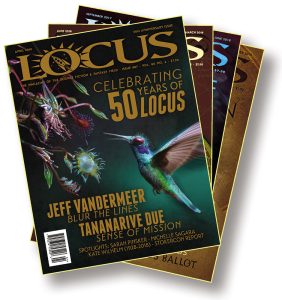The Year in Review 2024 by Russell Letson

(2022)
Trawling and Tunneling Through the Genres
I did not cast my net very wide this year – nine 2024 titles, with a couple of late 2023s and one early 2025 item included in the calendar year’s columns – and while the catch was small, everything I caught was a keeper, evidence of the variety that the fields of science fiction and fantasy continue to generate. I also noticed (again) how these sibling (or cousin?) fields overlap – how often they are distinguished, as George R.R. Martin once remarked, not by the stories they tell but by their ‘‘furniture,’’ which I take to include enabling devices. (That’s three metaphors so far, counting the title. I’ll try to restrain myself for the rest of this piece, but I make no promises.)
Exhibit A would be the work of Adrian Tchaikovsky, who this year as in others, produced sure-enough SF and fantasy novels, respectively Alien Clay and Days of Shattered Faith – both of which address matters of stubbornly fixed belief, governmental and institutional pathologies, and the way individuals get caught in those machineries. The metaphysics of their imagined worlds differ, but not the struggles of the characters, nor the rigor with which the rules of those worlds are worked out. (Ann Leckie and Charles Stross have also navigated similar genre-straining narratives set in rigorously constructed magical universes.) Also notable is Tchaikovsky’s consistent examinations of authoritarian structures and the ways that people resist or evade them – an interest that can’t not be rooted in a pained awareness of the pathologies of the last century-plus.
Speaking of rigor, few writers are more rigorous than Greg Egan, whose work often depends on working out the implications of strikingly counterfactual basic facts of life or at least deeply strange assumptions, often via conjectural alternate-world settings that are stoutly materialistic rather than magical/supernatural. In Morphotrophic, the counterfactuality consists of a reimagined cellular biology (what if our basic building-block constituents were a kind of collective democracy?), with a range of physiological results worked out in detail and then deployed in a storyline that blends intrigue-thriller and psychological portraiture with some sneakily sociopolitical thinking.
Free-associating along my reading list: Ray Nayler’s The Tusks of Extinction offers another kind of adventurous biology in the form of technologically resurrected woolly mammoths that need the help of the computationally resurrected personality of a long-dead elephant-behavior expert to guide them in learning how to survive in the wild. As with the Egan, the science-fictional Ideas (recreating extinct species, recording and implanting entire minds) are not only nifty in themselves but drivers of a moral vision of connectedness and the need to repair a looted and broken world.
If it were possible to establish thematic-motivic tunnels between books (finally the metaphor title over the mantelpiece in the title is going off), there would be one linking The Tusks of Extinction to Tchaikovsky’s Alien Clay, and then Alien Clay to James S.A. Corey’s The Mercy of Gods. The Tchaikovsky and Corey are linked by their portrayals of totalitarian control and prison-camp drama, and, as in The Tusks of Extinction, it is connection – social cohesion – that stands against evil. Tchaikovsky’s authoritarian bullies are completely human, operating out of an extended version of an ideological playbook and logistical system familiar from our recent actual history. The worldview of Corey’s alien interstellar overlords transcends that kind of merely political thinking and explicitly invites the reader to reconsider a range of power relationships and the very notion of a moral order altogether.
Another tunnel leads from Alien Clay and The Mercy of Gods and connects with the encounter-with-superior-aliens family of motifs. In the case of Jack McDevitt’s Doorway to the Stars, the aliens seem to be have visited Earth long ago, leaving behind durable but strangely homely artifacts and a transport network that leads to a rather comforting our-place-among-the-infinities resolution. Ancient alien visitors also figure in Ken MacLeod’s Lightspeed Trilogy, though the mysteries of their nature and decidedly un-comforting motives are only two threads in a long, three-volume story that intertwines more than a half-dozen motif families and Big Ideas drawn from the entire history of SF. The finale, Beyond the Light Horizon, is a 2024 book, but since I missed the middle volume, Beyond the Reach of Earth, I ignored the calendar and reviewed it alongside its sequel – and I’m defiantly recommending it for any year. It’s another version of that our-place-among-the-infinities theme, married to a busy, complex set of interlocking adventures and intrigues and political observations.
Alastair Reynolds’s Machine Vendetta and Linda Nagata’s Blade might seem like the odd couple at the wedding, seated at the same table for lack of plus-one companions, but they do in fact share the motif of the post- or transhuman condition as crucial components, despite very different subgeneric frames and ranges of other motif families deployed in their narrative spaces. Machine Vendetta is the last entry in Reynolds’s Prefect Dreyfus sequence, which projects police procedural and serial-killer patterns onto a future in which the villains can be psychotic artificial intelligences and the cast of characters can include seriously transformed humans – or pigs – and the sociopolitical settings can run variations on every conceivable model. It’s a gaudily expanded version of mean streets and corrupt wealth and guilty secrets. Nagata’s Blade uses the powers and agendas of posthuman and AI characters in service of an exploration of a deep galactic future with an even deeper past in which godlike entities can make or destroy entire worlds and where the Clarkean observation about technology that might as well be magic holds true.
Charles Stross’s A Conventional Boy is another item that is out of official calendar range, a 2025 book, but I reviewed it three months ago, and by the time you read this, it will have been out for weeks, and by next year that might seem like a long time ago. So: It is a retrospective (and even nostalgic) Laundry novel, reaching back to the 1980s and blending a fish-out-of-water nerd comedy with the usual dire results of messing with beings from the scary dark reaches of the multiverse. I’ll recommend it again next year, but it’s available right now.
So what does this tangle of strained metaphors and twisty tunnels somewhat all alike have to say about the past Year in SF/F? The usual: that our extended and cross-bred family of subgenres and conventions and motifs have not run out of the ability to generate compelling stories, to keep the attention of even the most jaded of longtime readers, to address old issues in new ways and new issues in old ways.
Top books of 2024:
The Mercy of Gods, James S.A. Corey
Morphotrophic, Greg Egan
Blade, Linda Nagata
The Tusks of Extinction, Ray Nayler
Beyond the Light Horizon, Ken MacLeod
Doorway to the Stars, Jack McDevitt
Machine Vendetta, Alastair Reynolds
Alien Clay, Adrian Tchaikovsky
Days of Shattered Faith, Adrian Tchaikovsky
Russell Letson, Contributing Editor, is a not-quite-retired freelance writer living in St. Cloud MN. He has been loitering around the SF world since childhood and been writing about it since his long-ago grad school days. In between, he published a good bit of business-technology and music journalism. He is still working on a book about Hawaiian slack key guitar.
This report and more like it in the February 2025 issue of Locus.
 While you are here, please take a moment to support Locus with a one-time or recurring donation. We rely on reader donations to keep the magazine and site going, and would like to keep the site paywall free, but WE NEED YOUR FINANCIAL SUPPORT to continue quality coverage of the science fiction and fantasy field.
While you are here, please take a moment to support Locus with a one-time or recurring donation. We rely on reader donations to keep the magazine and site going, and would like to keep the site paywall free, but WE NEED YOUR FINANCIAL SUPPORT to continue quality coverage of the science fiction and fantasy field.
©Locus Magazine. Copyrighted material may not be republished without permission of LSFF.







